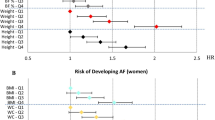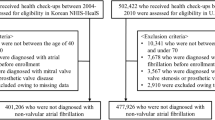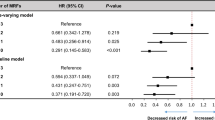Abstract
The validity of atrial fibrillation (AF) diagnoses in national registers for use as endpoints in prospective studies has not been evaluated. We studied the validity of AF diagnoses in Swedish national hospital discharge and cause of death registers and the occurrence of and risk factors for AF in a middle-aged Swedish population using these registers. Our study included the 30,447 individuals (age 44–73) who attended baseline visits in 1991–1996 of the Malmö Diet and Cancer study. Individuals with a first AF diagnosis were identified by record linkage with national registers. A subset of cases was randomly selected for validation by examination of electrocardiograms and patient records. Electrocardiograms were available in 98% of the validation sample (95% definitive AF, 3% no AF). The 2% with ECGs unavailable had probable AF. Baseline AF prevalence was 1.3%, higher in men and increased with age. During 11.2 years of follow-up 1430 first AF diagnoses occurred. Risk factors were age, hypertension, BMI, diabetes, history of heart failure, history of myocardial infarction and, in men but not women, current smoking. The strongest risk factors were history of heart failure (hazard ratio men 4.5, women 8.7) and myocardial infarction (hazard ratio men 2.0, women 1.8). The largest population attributable risks were observed for hypertension (men 38%, women 34%) and obesity (men 11%, women 10%). In conclusion, case misclassification of AF in national registers is small, indicating feasibility of use in prospective studies. Hypertension and obesity account for large portions of population risk in middle-aged individuals with low prevalence of manifest cardiac disease.


Similar content being viewed by others
Abbreviations
- AF:
-
Atrial fibrillation
- ECG:
-
Electrocardiogram
- PAR:
-
Population attributable risk
- MDCS:
-
The Malmö Diet and Cancer Study
- BMI:
-
Body mass index
- HDR:
-
The Swedish Hospital Discharge Register
- CDR:
-
The Swedish Cause of Death Register
- ICD:
-
The International Classification of Diseases
- HR:
-
Hazard ratio
- 95% CI:
-
95% confidence interval
References
Lloyd-Jones DM, Wang TJ, Leip EP, et al. Lifetime risk for development of atrial fibrillation: the Framingham heart study. Circulation. 2004;110:1042–6.
Stewart S, Hart CL, Hole DJ, McMurray JJ. A population-based study of the long-term risks associated with atrial fibrillation: 20-year follow-up of the Renfrew/Paisley study. Am J Med. 2002;113:359–64.
Wang TJ, Larson MG, Levy D, et al. Temporal relations of atrial fibrillation and congestive heart failure and their joint influence on mortality: the Framingham heart study. Circulation. 2003;107:2920–5.
Shinbane JS, Wood MA, Jensen DN, Ellenbogen KA, Fitzpatrick AP, Scheinman MM. Tachycardia-induced cardiomyopathy: a review of animal models and clinical studies. J Am Coll Cardiol. 1997;29:709–15.
Wolf PA, Abbott RD, Kannel WB. Atrial fibrillation as an independent risk factor for stroke: the Framingham study. Stroke. 1991;22:983–8.
Braunwald E. Shattuck lecture–cardiovascular medicine at the turn of the millennium: triumphs, concerns, and opportunities. N Engl J Med. 1997;337:1360–9.
Miyasaka Y, Barnes ME, Gersh BJ, et al. Secular trends in incidence of atrial fibrillation in Olmsted County, Minnesota, 1980 to 2000, and implications on the projections for future prevalence. Circulation. 2006;114:119–25.
Hammar N, Alfredsson L, Rosén M, Spetz CL, Kahan T, Ysberg AS. A national record linkage to study acute myocardial infarction incidence and case fatality in Sweden. Int J Epidemiol. 2001;30(Suppl 1):S30–4.
Lindblad U, Råstam L, Ranstam J, Peterson M. Validity of register data on acute myocardial infarction and acute stroke: the Skaraborg hypertension project. Scand J Soc Med. 1993;21:3–9.
Ingelsson E, Arnlöv J, Sundström J, Lind L. The validity of a diagnosis of heart failure in a hospital discharge register. Eur J Heart Fail. 2005;7:787–91.
Merry AHH, Boer JMA, Schouten LJ, Feskens EJ, Verschuren WM, Gorgels AP, et al. Validity of coronary heart diseases and heart failure based on hospital discharge and mortality data in the Netherlands using the cardiovascular registry Maastricht cohort study. Eur J Epidemiol. 2009;24:237–47.
Einthoven W. Le telecardiogramme. Arch Int de Physiol. 1906;4:132–64.
Hering HE. Das Elektrocardiogramm des Pulsus Irregularis perpetuus. Deutsches Archiv für Physiologie. 1908;94:205–8.
Fuster V, Rydén LE, Cannom DS, et al. ACC/AHA/ESC 2006 guidelines for the management of patients with atrial fibrillation: a report of the American College of Cardiology/American Heart Association task force on practice guidelines and the European Society of Cardiology committee for practice guidelines (writing committee to revise the 2001 guidelines for the management of patients with atrial fibrillation): developed in collaboration with the European heart rhythm association and the Heart rhythm society. Circulation. 2006;114:e257–354.
Berglund G, Elmståhl S, Janzon L, Larsson SA. The Malmö diet and cancer study. Design and feasibility. J Intern Med. 1993;233:45–51.
Persson M, Hedblad B, Nelson JJ, Berglund G. Elevated Lp-PLA2 levels add prognostic information to the metabolic syndrome on incidence of cardiovascular events among middle-aged nondiabetic subjects. Arterioscler Thromb Vasc Biol. 2007;27:1411–6.
Benjamin EJ, Levy D, Vaziri SM, D’Agostino RB, Belanger AJ, Wolf PA. Independent risk factors for atrial fibrillation in a population-based cohort. The Framingham Heart Study. JAMA. 1994;271:840–4.
Psaty BM, Manolio TA, Kuller LH, et al. Incidence of and risk factors for atrial fibrillation in older adults. Circulation. 1997;96:2455–61.
Waldo AL, Feld GK. Inter-relationships of atrial fibrillation and atrial flutter. J Am Coll Cardiol. 2008;51:779–86.
Benjamin EJ, Chen P, Bild DE, et al. Prevention of atrial fibrillation: report from a National Heart, Lung, and Blood Institute workshop. Circulation. 2009;119:606–18.
Levin ML. The occurrence of lung cancer in man. Acta Unio Int Contra Cancrum. 1953;9:531–41.
Walter SD. The estimation and interpretation of attributable fraction in health research. Biometrics. 1976;32:829–49.
Go AS, Hylek EM, Phillips KA, Chang Y, Henault LE, Selby JV, et al. Prevalence of diagnosed atrial fibrillation in adults: national implications for rhythm management and stroke prevention: the anticoagulation and risk factors in atrial fibrillation (ATRIA) study. JAMA. 2001;285:2370–5.
Feinberg WM, Blackshear JL, Laupacis A, Kronmal R, Hart RG. Prevalence, age distribution, and gender of patients with atrial fibrillation. Analysis and implications. Arch Intern Med. 1995;155:469–73.
Engström G, Hedblad B, Juul-Möller S, Tydén P, Janzon L. Cardiac arrhythmias and stroke. Increased risk in men with high frequency of atrial ectopic beats. Stroke. 2000;31:2925–9.
Furberg CD, Psaty BM, Manolio TA, Gardin JM, Smith VE, Rautaharju PM. Prevalence of atrial fibrillation in elderly subjects (the Cardiovascular Health Study). Am J Cardiol. 1994;74:236–41.
Wang TJ, Parise H, Levy D, D’Agostino RB Sr, Wolf PA, Vasan RS, et al. Obesity and the risk of new-onset atrial fibrillation. JAMA. 2004;292:2471–7.
Frost L, Hune LJ, Vestergaard P. Overweight and obesity as risk factors for atrial fibrillation or flutter: the Danish diet, cancer, and health study. Am J Med. 2005;118:489–95.
Rosengren A, Hauptman PJ, Lappas G, Olsson L, Wilhelmsen L, Swedberg K. Big men and atrial fibrillation: effects of body size and weight gain on risk of atrial fibrillation in men. Eur Heart J. 2009;30:1113–20.
Levy D, Larson MG, Vasan RS, Kannel WB, Ho KKL. The progression from hypertension to congestive heart failure. JAMA. 1996;275:1557–62.
Conen D, Tedrow UB, Koplan BA, Glynn RJ, Buring JE, Albert CM. Influence of systolic and diastolic blood pressure on the risk of incident atrial fibrillation in women. Circulation. 2009;119:2146–52.
Yusuf S, Hawken S, Ounpuu S, et al. Effect of potentially modifiable risk factors associated with myocardial infarction in 52 countries (the INTERHEART study): case-control study. Lancet. 2004;364:937–52.
Schoonderwoerd BA, Smit MD, Pen L, van Gelder IC. New risk factors for atrial fibrillation: causes of ‘not so lone atrial fibrillation’. Europace. 2008;10:668–73.
Acknowledgments
MDCS was made possible by grants from the Malmö city council. J. Gustav Smith gratefully acknowledges financial support from the Swedish Heart Lung Foundation. Pyotr Platonov was supported by governmental funding for clinical research within the Swedish NHS. Olle Melander was supported by grants from the Swedish Medical Research Council, the Swedish Heart and Lung Foundation, the Medical Faculty of Lund University, Malmö University Hospital, the Albert Påhlsson Research Foundation, the Crafoord foundation, the Ernhold Lundströms Research Foundation, the Region Skane, the Hulda and Conrad Mossfelt Foundation, the King Gustaf V and Queen Victoria Foundation, the Lennart Hanssons Memorial Fund, the Wallenberg Foundation.
Author information
Authors and Affiliations
Corresponding author
Rights and permissions
About this article
Cite this article
Smith, J.G., Platonov, P.G., Hedblad, B. et al. Atrial fibrillation in the Malmö diet and cancer study: a study of occurrence, risk factors and diagnostic validity. Eur J Epidemiol 25, 95–102 (2010). https://doi.org/10.1007/s10654-009-9404-1
Received:
Accepted:
Published:
Issue Date:
DOI: https://doi.org/10.1007/s10654-009-9404-1




